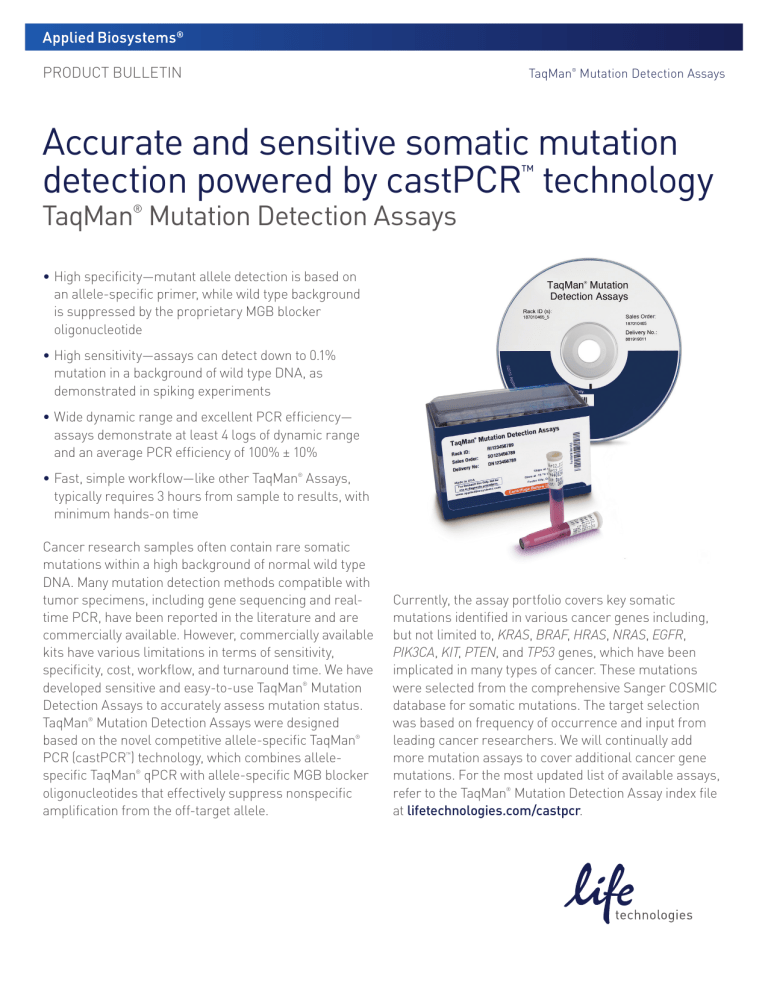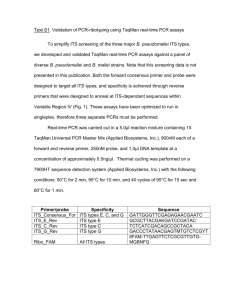
PRODUCT BULLETIN
TaqMan Mutation Detection Assays
®
Accurate and sensitive somatic mutation
detection powered by castPCR technology
™
TaqMan Mutation Detection Assays
®
• High specificity—mutant allele detection is based on
an allele-specific primer, while wild type background
is suppressed by the proprietary MGB blocker
oligonucleotide
• High sensitivity—assays can detect down to 0.1%
mutation in a background of wild type DNA, as
demonstrated in spiking experiments
• Wide dynamic range and excellent PCR efficiency—
assays demonstrate at least 4 logs of dynamic range
and an average PCR efficiency of 100% ± 10%
• Fast, simple workflow—like other TaqMan Assays,
typically requires 3 hours from sample to results, with
minimum hands-on time
®
Cancer research samples often contain rare somatic
mutations within a high background of normal wild type
DNA. Many mutation detection methods compatible with
tumor specimens, including gene sequencing and realtime PCR, have been reported in the literature and are
commercially available. However, commercially available
kits have various limitations in terms of sensitivity,
specificity, cost, workflow, and turnaround time. We have
developed sensitive and easy-to-use TaqMan Mutation
Detection Assays to accurately assess mutation status.
TaqMan Mutation Detection Assays were designed
based on the novel competitive allele-specific TaqMan
PCR (castPCR ) technology, which combines allelespecific TaqMan qPCR with allele-specific MGB blocker
oligonucleotides that effectively suppress nonspecific
amplification from the off-target allele.
®
®
®
™
®
Currently, the assay portfolio covers key somatic
mutations identified in various cancer genes including,
but not limited to, KRAS, BRAF, HRAS, NRAS, EGFR,
PIK3CA, KIT, PTEN, and TP53 genes, which have been
implicated in many types of cancer. These mutations
were selected from the comprehensive Sanger COSMIC
database for somatic mutations. The target selection
was based on frequency of occurrence and input from
leading cancer researchers. We will continually add
more mutation assays to cover additional cancer gene
mutations. For the most updated list of available assays,
refer to the TaqMan Mutation Detection Assay index file
at lifetechnologies.com/castpcr.
®
About the assays
TaqMan Mutation Detection Assays contain mutant
allele assays, which specifically detect one or more
mutant alleles, and corresponding gene reference
assays, which detect mutation-free regions of the genes
in which the target mutations reside (Figure 1). The
validated assay set additionally includes corresponding
wild type allele assays (not described here; refer to the
TaqMan Mutation Detection Assay protocol for further
information).
®
(e.g., gDNA from FFPE tissue samples, Figure 2). ΔCt
values are calculated for each sample run with a mutant
allele assay/gene reference assay pair. The average ΔCt
value for all samples is then calculated and is used to
derive the detection ΔCt cutoff value for the mutant allele
assay.
Two experiment types
Two types of experiments are required for mutation
detection analysis:
2. Mutation detection
A test sample is run with one or more mutant allele
assays and a corresponding gene reference assay
(Figure 2). The ΔCt value for the mutant allele assay/
gene reference assay pair is calculated, and this value
is compared to the previously determined detection ΔCt
cutoff value to determine the sample mutation status.
1. Detection ΔCt cutoff determination
A mutant allele assay and corresponding gene reference
assay are run on three or more wild type gDNA samples
that are from the same sample type as the test samples
Optional use of internal positive control (IPC)
You can duplex the IPC reagents with any TaqMan
Mutation Detection Assay to distinguish true target
negatives from PCR failure or inhibition (Figure 3).
®
®
Figure 1. TaqMan Mutation Detection Assay types.
®
Assay type
Description
Schematic
Mutant allele assay
• Detects specific or multiple mutant alleles
• An allele-specific primer detects the mutant allele
• An MGB blocker oligonucleotide suppresses the wild type allele
ASP = Allele-specific primer
ASB = Allele-specific blocker (MGB)
LST = Locus-specific TaqMan probe
LSP = Locus-specific primer
®
Gene reference assay
• Detects the gene within which the target mutations reside
• A locus-specific pair of forward and reverse primers amplifies a mutationfree region of the target gene
FP = Forward primer
RP = Reverse primer
LST = Locus-specific TaqMan probe
®
Figure 2. Gene reference and mutant allele assays are run with a genomic DNA sample to
determine the mutation status of each target mutation within the cancer gene.
Region with mutations
Mutation-free region
Ref
Reference assay for
target gene
Mu
Mu
Mu
Mu
Mu
Mutant allele assays for target mutations
Figure 3. Internal positive controls. The TaqMan Mutation Detection IPC Reagent Kit is a set of
optional internal positive control reagents that can be duplexed with any TaqMan Mutation Detection
Assay to provide a positive PCR control result. The IPC reagents can distinguish a mutation target
negative result from a PCR failure result.
®
®
cast
TM
Procedure
Purified gDNA, extracted from a sample with an
unknown mutation status, is run with one or more
mutant allele assays and the corresponding gene
reference assay. For each real-time PCR reaction, the
gDNA is combined with:
Reactions are run on a real-time PCR system, using
a universal mutation detection thermal cycling
protocol. After the run, the real-time PCR system‘s
analysis software determines the Ct values for each
TaqMan Mutation Detection Assay and (optional)
IPC reagent reactions. Real-time results export
files can be opened in the free Mutation Detector
Software for post-PCR data analysis. The Ct difference
between each mutant allele assay and reference
assay is calculated. This ΔCt value, which represents
the quantity of a specific mutant allele detected in a
sample, is used to determine sample mutation status
by comparison to a previously determined detection
ΔCt cutoff value. You can search for, or download a
list of, currently available TaqMan Mutation Detection
Assays at lifetechnologies.com/castpcr.
®
™
• A TaqMan Mutation Detection Assay—contains two
primers and a FAM dye–labeled MGB probe to detect
a mutant allele or reference gene target. Mutant allele
assays also contain an MGB oligonucleotide blocker.
®
™
• TaqMan Genotyping Master Mix—contains AmpliTaq
Gold DNA Polymerase UP (Ultra Pure), dNTPs, and
buffer
®
®
• (Optional) TaqMan Mutation Detection IPC Reagent
Kit—contains an internal positive control (IPC)
template, two primers, and a VIC dye–labeled
TAMRA probe. It can be used to distinguish true target
negatives from PCR failure or inhibition.
®
®
®
™
Note: All TaqMan Mutation Detection Assays have undergone extensive testing to ensure high sensitivity and specificity.
The first set of released assays, covering 14 KRAS, 29 EGFR, and the BRAF V600E mutations, underwent additional
testing, including determination of: the inherent amplification efficiency difference between mutant allele assays and
corresponding reference assays, to enable quantitative analysis of percent mutation in a sample; and assay detection
ΔCt cutoff values using spiked cell line gDNA samples.
®
Assay performance
Specificity
Mutant allele detection is based on an allele-specific
primer, while the wild type allele background
is suppressed by the proprietary MGB blocker
oligonucleotide. Assays can detect down to 0.1% mutant
allele in the presence of a wild type allele background
(Figure 4).
Figure 4. Ct difference between 0.1% mutation samples and wild type
gDNA. For each assay, 0.1% mutant allele samples were obtained
by spiking 10 copies of mutant allele synthetic templates into 10,000
copies of cell line wild type gDNA. (A) Example of amplification plot
for KRAS_522_mu assay on 0.1% mutant allele sample and wild type
gDNA. (B) There is a significant difference in amplification Ct values
between the 0.1% mutant allele sample and wild type gDNA (P value
< 0.05 for 46 out of 48 assays in the example graph).
A
High sensitivity
TaqMan Mutation Detection Assays can detect as few as
1–5 mutant copies in up to one million copies of wild type
background. Assay sensitivity is demonstrated using
synthetic template spiking experiments (Figure 5 and 6).
®
Wide dynamic range and excellent PCR efficiency
Assays demonstrate up to 7 logs of dynamic range and
an average PCR efficiency of 100% ± 10% (Figure 6).
Figure 5. Assay sensitivity and selectivity. For every single assay, the
sensitivity and selectivity were analyzed through synthetic template
spiking experiments. 10 copies to 10 5 copies of mutant allele synthetic
template were spiked into a constant background of 10 5 copies of wild
type cell line genomic DNA. For a subset of the assays, 1 copy to 10 6
copies of mutant allele synthetic template were spiked into a constant
background of 10 6 copies of wild type allele synthetic template. In the
example shown, the BRAF_476_mu assay can detect 1 copy of mutant
allele in a background of 10 6 copies of wild type allele.
40.0
y = -3.332x + 36.075
R2 = 0.9992
35.0
Mutant
Wild type
30.0
Ct
25.0
20.0
15.0
10.0
Mutant
1
Wild type 106
10
102
103
104
105
106 copies
106
106
106
106
106
106 copies
Figure 6. Assay dynamic range. Each assay was tested with 10 copies
to 10 copies of synthetic template within a constant background of
10 copies of wild type genomic DNA. A subset of the assays was
tested with 10 copies to 1 copy of synthetic template within a constant
background of 10 copies of wild type allele synthetic template. In
the example shown, the KRAS_532_mu assay has 7 logs of dynamic
range, with an average PCR efficiency of 100% ± 10%.
5
5
7
B
7
Accuracy and reproducibility
Assays demonstrate excellent reproducibility and
accurate quantification (Table 1).
Data analysis software
For data analysis, Mutation Detector Software allows
users to determine the mutation status and quantify
the % mutation of their samples from TaqMan
Mutation Detection Assay data collected on the Applied
Biosystems ViiA 7, 7900HT, 7500, 7500 Fast, and
StepOnePlus Real-Time PCR Systems (Table 2).
™
®
Sample type compatibility
The assays can be used with gDNA samples extracted
from FFPE tissues, fresh frozen tissues, and cell lines.
®
™
™
Table 1. Accuracy and reproducibility. Selected assays were tested in gDNA spiking experiments. In the
example shown, G12C mutant cell line gDNA was spiked into wild type cell line gDNA at percentages ranging
from 100% to 0.1%. The measured percent mutation was averaged from three experiment runs. The measured
percent mutation is highly concordant with the expected percent mutation (R = 0.9997). Accurate and precise
quantification (CV < 20%) is obtained among the replicate runs when the target allele copy number is >30.
2
Copy number, target mutant allele
Expected (%)
Measured (%)
CV (%)
3,000
100.0
100.0
0.0
1,500
50.0
48.9
2.2
750
25.0
23.3
3.8
375
12.5
11.2
7.8
188
6.3
5.7
7.5
90
3.0
2.6
9.0
30
1.0
0.8
17.0
15
0.5
0.4
26.0
3
0.1
0.1
23.0
Table 2. Instrument compatibility.
Applied Biosystems real-time PCR system
Block module
Software version
StepOnePlus system
Fast 96-Well Block Module
StepOne Software v2.X
7500 system
Standard 96-Well Block Module
SDS v1.X and v2.X
7500 Fast system
Fast 96-Well Block Module
SDS v1.X and v2.X
7900HT Fast system
Standard 96-Well Block Module, Fast 96-Well Block Module,
384-Well Block Module
SDS v2.X
ViiA 7 system
Standard 96-Well Block Module, Fast 96-Well Block Module,
384-Well Block Module
ViiA 7 Software v1.X
®
TM
TM
QuantStudio 12K Flex system
®
Standard 96-Well Block Module, Fast 96-Well Block Module,
384-Well Block Module
TM
TM
QuantStudio Software v1.0
®
Ordering information
Product
Quantity
Cat. No.
TaqMan Mutation Detection Assays
150 µL, 10X
4465804
TaqMan Mutation Detection Reference Assays
150 µL, 10X
4465807
TaqMan EGFR Exon 19 Deletions Assay
150 µL, 10X
4465805
TaqMan Mutation Detection IPC Reagent Kit
1 kit
4467538
®
®
®
®
For more information and full terms of the TaqMan Assays QPCR
Guarantee, go to lifetechnologies.com/taqmanguarantee
®
For Research Use Only. Not for use in diagnostic procedures. © 2014 Thermo Fisher Scientific Inc. All rights reserved. All trademarks are
the property of Thermo Fisher Scientific and its subsidiaries unless otherwise specified. TaqMan and AmpliTaq Gold are registered trademarks of
Roche Molecular Systems, Inc., used under permission and license. CO011169 0814





